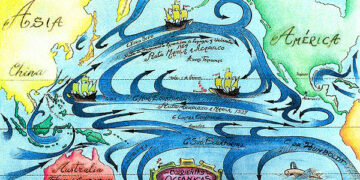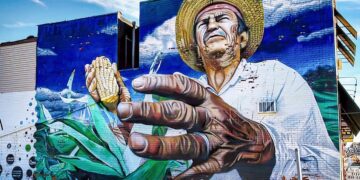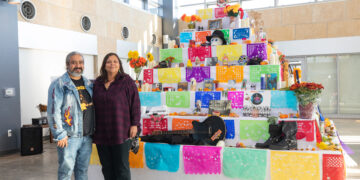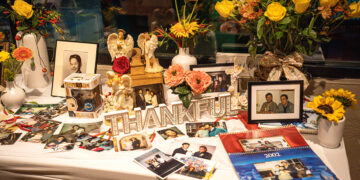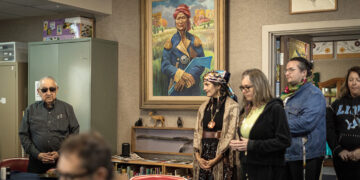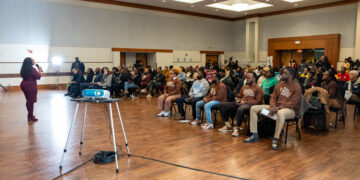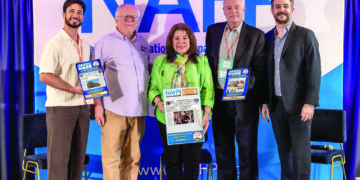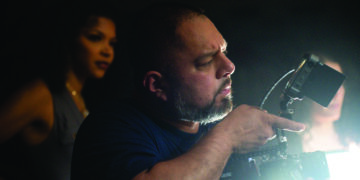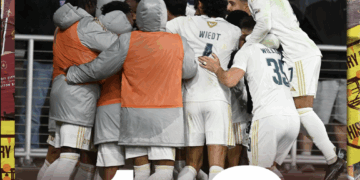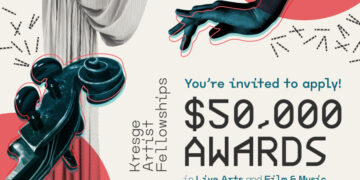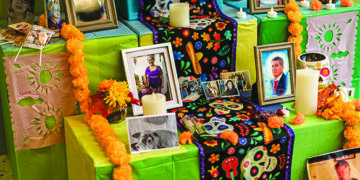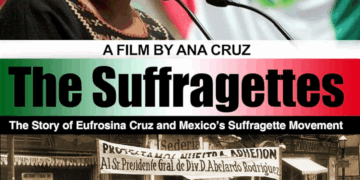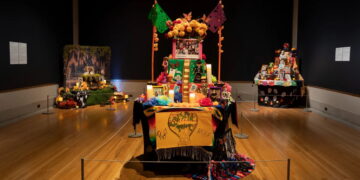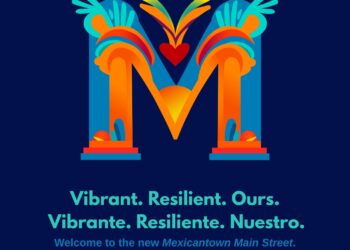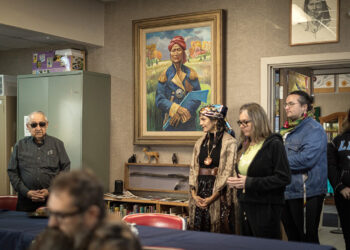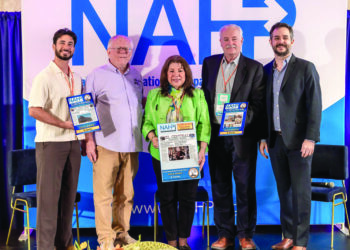Vito Valdez: So, it’s March 17th , 2023, 2:15pm. And I’m here with Michael Menchaca. And they are here vising Detroit for their first time. And so, Michael I guess you’re here…you’ve been invited here [to Detroit]? Correct?
Michael Menchaca: Yes!
Vito: And could you tell us about that invitation?
Michael: Yeah, so Clare Rogan (Curator of Prints and Drawings at the DIA) included my suite of sixteen prints, La Raza Cósmica 20XX, that was printed published by Julia Samuels with Overpass Projects press, located in Providence, RI into the exhibition currently on view at the DIA called Printmaking in the 21st Century. And so that set of prints was acquired by the DIA. I’m also humbled to be showing alongside many other talented Detroit artists including yourself, Vito Valdez, and also Tyanna J. Buie, and Sabrina Nelson who I got to meet the other day. This is the first me seeing LRC20XX in a museum, so upon invitation, I came to give a lecture and describe my research in putting the pictures which references a lot of Spanish Colonial history and is also influenced by the Mixtec and pre-Columbian American history alongside Big Tech icons speaking critically to the current infodemic age and putting together all these influences with a digital spin in terms of the pictographic vocabulary. Because this is a lot of research, I focused my lecture into giving people a glimpse into all those elements and what goes on in the studio and try to provide an education on why you should maybe reconsider how friendly you are with the tech that you probably engage with on a daily basis.
Vito: Wow! That’s a vivid description of your work and congratulations on your work being in DIA. I’ve seen the show. It’s fabulous work, and I heard the lecture. And in the lecture, which was very informative, and really hit on some very important information that I think everyone should be aware of, especially with what’s happening with Facebook and these platforms that are out there. I have my opinions on them and they align quite closely with your conclusions with that and where it’s going. Could you give us a little more information for our readers out there on the lecture? In the lecture you reference some books flooding the mainstream bookstores out there. There’s a lot of great resources, especially Shoshanna Zuboff’s Surveillance Capitalism and Ruha Benjamin’s Race Aer Technology.
Michael: Surveillance Capitalism lays out the foundation of a critique of what happened at Google in 2001 shortly after 9/11 and how the Department of Homeland Security partnered with Google to monitor what online users were clicking on and then how Google was in a position to anticipate and monetize on what became called the “click-thru rate”. This economic model then moved to Facebook via Sheryl Sandberg, who worked at both companies, to use the same economic logic to track FB user’s online behavior in order to sell them targeted ads. In short, Google and Facebook then became really rich and then this model became the foundation for how every other company would pay themselves and their clients. So now we the users don’t have a choice but to accept the surveillance that’s embedded in our technology that keeps these businesses in business. And I’m concerned as an artist that if we live and create work in an ad-based market, and ads are the priority, then our tools for creating are spying on us and we’re subliminally being influenced to prioritize paid commercial and political outcomes. I don’t accept that premise.
Vito: This also applies to the public at large…facial recognition that’s being used by governments all over the world. China is a good example.
Michael: Yeah, it’s a social credit system, and China knows how to use these systems to control its population, and in a Democracy like the US, to try to socially control through the digital is inherently anti-democratic. So, I’m visually exposing that flaw and that the tech does not need to have surveillance tools embedded in them to work.
Vito: For our readers in Southwest Detroit, they may find it interesting to know, especially the refugee situation we have in this country, how they’re being monitored. Like how we had that local case on a false accusation of a crime that was featured in your lecture.
Michael: Right! there was a false match of a case here in Detroit where someone was accused of a crime they did not commit by a facial recognition company (DataWorks Plus) that supplied software to Michigan State Police. So, we are living in a new era of civil rights concerns where you can be falsely accused of a crime via an algorithm. Like, a computer error can completely change your life and stigmatize your family’s life because there’s already an intrinsic criminality ascribed to skin color, that’s the historical legacy of the caste system that is the Spanish colonial foundation of the European occupation of Americas. The U.S. implemented that same discriminatory visual criminalization and racialization on a population that it deemed as less socially valuable from its inception. Coming from Texas, and we’re really close to Mexico, there’s already a lot of distrust of those of Mexican identity, and that’s inherently the foundation of Texas; was to basically steal the geography from Mexico, displace the local population or assimilate us into being like the conqueror. And so, I’ve grown up with an inferiority complex of internalizing verguenza, shame, just for looking and appearing to be myself; a Mexican American. And I’m sure that’s the same here in Michigan.
Vito: I’ve experienced that as well as many others in our culture. We definitely have something in common there. And speaking on this topic, I’m thinking about how you’re in Detroit. And Detroit, being the Motor Capital, has a long history of discrimination based on color and class and outsourcing, and the thing about employment in the auto business, how they would want to put people to work. These people, they would feed them information that would make them feel threatened by the Japanese imports. Vincent Chin was a Japanese person in the company of friends. I believe this happened on the Eastside of Detroit where he was confronted by an auto factory worker over Japanese auto imports and subsequently beaten to death. It goes along with that whole business. Fear and Threat of the Other.
Michael: That xenophobia is part of a whole nationalistic identity of defining the melting pot of America as this ideological diverse population, but one that usually favors the European lineage, and then everyone else is seen as “foreign” or othered.
Vito: Yes, marginalized at birth!
Michael: Unless historically marginalized populations living here in the U.S. overtly demonstrate xenophobic nationalistic pride and reproduce harm under the name of the state, and that’s the assimilation politics that I’ve come to reject within myself. No longer feeling like I need to compensate for my brownness by reproducing racist harm or anything “Stockholm Syndrome” like. Now I’m critiquing it by co-opting the language of commercial racism and showing the absurdity in that logic. And that’s why it’s confusing to show my work out of context. That’s why I opt to show my work only in very specific situations, in art galleries, and in museums. Spaces where I can control the context. Not spaces without my creative control. And so that’s been a very difficult thing to maintain is creative control.
Vito: So, your work can be seen online…
Michael: Yes, on my website: michaelmenchaca.com
Vito: How would you describe what the general public might see when they look at your work and the message you’re trying to get across?
Michael: Yeah, I often don’t get to hear that interpretation unless I’m present when the work is on display. And because I’ve been social distancing over the last few years. Recently I’ve been seeing the reaction from what people think here about the tech heavy artwork and my references to the US caste system. I’ve noticed that the Anglo population does not understand the caste system and how it relates to the gato mythology and how it’s about mestizaje and the colonial era breeding as people have occupied the Americas. I’ve decided to represent mestizaje through different variations of feline lineage and other animal archetypes to tell the story of mestizaje and going back to it being misinterpreted by the more dominant caste here in the U.S. Is that they’ll see cats and be fixated on cats and then think of internet culture, and only see novelty. And I can say that with confidence because there was a case where the show Printing the Revolution! curated by E Carmen Ramos and Claudia Zapata, a great friend of mine from my same barrio in SA, and an activist curator at that, where this show traveled to Fort Worth, TX in ‘21 or ’22 and the local curator for that museum gave an online tour on YouTube and spoke of the cats in my early screen-prints as being a direct reference to cats of internet culture. That is just misinformation. That early work is directly addressing a personal sense of cultural alienation through narrative images of migration. I had not yet infused a critique on the internet in that early work. By the way Claudia Zapata just started a post doctorate fellowship at UCLA. They’re trying to curate and keep up with digital means of producing art in the 21st century and bring in the Lanx, Lané, Chicanx, Hispanic element. And there are all these names we can’t agree on because we are so diverse. And inherently there is conflict in our history and in our communities and we start to police each other’s language like the Spanish police. Like I’ve grown up attempting to speak Spanish and it’s not correct enough for some folks and for other’s they’d rather only speak English because they’ve assimilated, and they get “cultural cringe” when they hear Spanish.
Vito: I fall into that category myself.
Michael: And myself too. I’ve unlearned my Spanish having grown up in TX. Anyway, that’s another story but it’s ed to this one.
Vito: So just to kind of have something to leave to Detroit.
Michael: I think I’ve lost track of the question. (laughter)
Michael: To see themselves reflected in my work. And my experiences mirroring their experiences. That’s what I would hope and that’s what it sounds like from Doris, one of the educators at DIA, sounds like, when they give tours to the kids, Doris prompts them to say what do they see in the art, and in my prints in particular that she features, and I’m really humbled by that, but she says that they say that “technology is not the bad guy, but that we just have to be careful with how we use tech.” They understand that we’re talking about the present, that this isn’t ancient history but that it’s both. but it’s a historical way of looking at race and identity but that the technology is infused with that technology that its baked in and Ruha Benjamin calls it “coded inequity”, and I’m trying to make that very visible. That race is a technology in itself. It’s also embedded within our tech tools, and I’m not going to take that history for granted. I will question tech’s ability to maintain social control and the racial hierarchy that is already here. Tech is not going to change things unless that is how it’s going to be used, to disrupt the current social order and intentionally decolonize. Until that’s made explicit and until that is the mission of these corporations then nothing is going to change. We can expect it to maintain and in fact increase the disparity across the racial gaps unless something different is done. I’m trying to tell the public that we need to start saying that “this is not cool.” I’m not okay with this and I want people to see that they’re not okay with this. I think people sense that something is not ok. We all feel used. We can’t watch the Superbowl anymore. I don’t have cable so I have to download an app… and connect the phone to the tv and then those signals are being monitored and sending us geographic specific commercials. It’s just a different economy. But I think we need to detox…and go back to going to our own mental abilities and go back to being grounded to the earth. I hope that people take that away when they look at my pictures.
Vito: One last thought about your trip to Detroit. This is your first trip and we just returned from a trip to southwest Detroit. I’m wondering what your thoughts are on vising Southwest Detroit.
Michael: We just had the best nopales tacos that we’ve ever had. And it was on the menu so that was like…
Vito: Compared to San Antonio?
Michael: Yes because Texas loves cheese. There is a huge cheese cultura, Enchiladas…And us being vegan, that further marginalizes us even within Latinidad. We stick to plant-based foods, so we are always asking the weird questions “is there lard in them beans?”
Vito: That’s a good shout out to Southwest and Lupitas. I’m the same way, for those that are vegan, let’s give southwest more options for vegans. And looking for alternative options.
Michael: Food is medicine, and we need to return to that idea.
Vito: Well we hope you can return and it’s been a pleasure.
Michael: Thank you so much.
Vito Valdez is a Southwest Detroit based artist/educator. He is a second generation Mexican American Vietnam Era conscientious objector army veteran.

